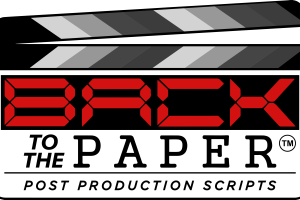What’s a CCSL?
CCSL stands for Combined Continuity and Spotting List. It is actually two documents in one, running concurrently. They are extremely detailed and lengthy strips, comprising of the ‘action continuity’ — cut by cut shot description and all the dialogue and sound effects written in the greatest of detail. Often reaching over 200 pages a CCSL is a paper representation of the actual film on screen.
Continuity Script: The left part of the CCSL is the continuity list, often called action continuity, which is the visual part of the video or film.
To prepare the continuity list for a movie, our writers go through the video to capture the time code for each individual camera shot. After which they carefully evaluate each shot (which can average 1200-1600 per for a one hour movie, to determine the type of shot, the characters in the shot as well as any pertinent objects or scenery, and any action that happens during the shot.
Spotting List: And to the right side is the ‘spotting list’ which is the audio part of the video or film.
For creating the spotting list, we follow our normal closed captioning procedures. Once the text of the video is transcribed and timed, an editor proofreads the dialogue, as well as adding speaker and subject IDs. The spotting list includes all dialogue, music, and sound effects, structured as they would appear as captions, with speaker and who is being spoken to identification.
Finally, we layout the two documents so that they run concurrently, meaning that all captions are displayed adjacent to the shot during which they occur.
Add Closed Captioning for only $2 per minute
How are we able to add a closed captioning file for just $2 per minute when our regular charge for creating a stand alone closed captioning file is $6.00 per minute?
Back To The Paper started off as a closed captioning service in 2003. After 10 years of experience with closed captioning when we worked on our first CCSL, we realized that we had an advantage over our competitors who were still capturing the time codes for a CCSL manually (by literally typing it). This took a lot of time and was prone to mistakes. We decided to continue using our closed captioning software to capture time code (it is done manually using a software to capture the frame precise time code).
So to create a CCSL we start the process by first creating a closed captioning file. From here on, there is a lot less work required to bring this closed captioning file to a broadcast quality closed captioning – for which we charge only $2.00 per minute.
Which is why it makes perfect sense to take care of your closed captioning file while you are getting the CCSL done.
CCSL Samples
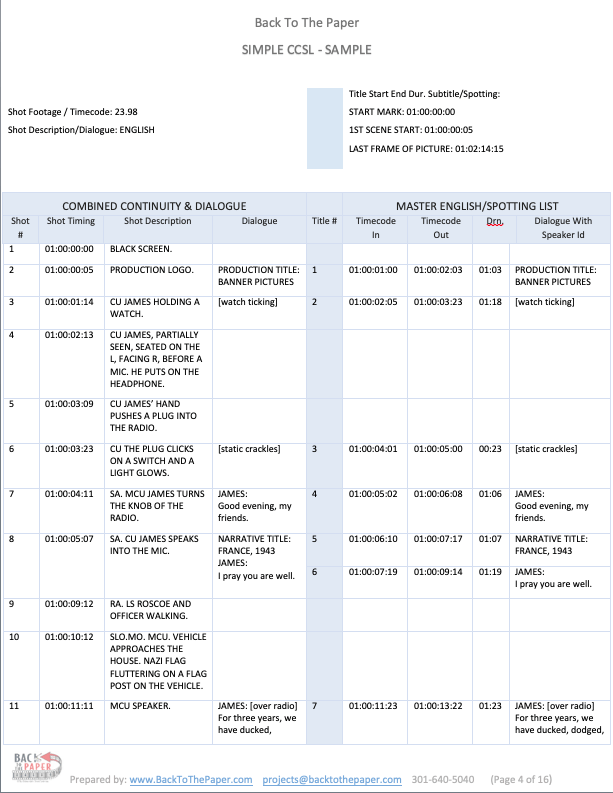
Simple CCSL
$16.00 per minute
Includes:
- Scene number
- Scene time code
- Succinct scene descriptions
- Dialog number
- Dialogue Time Code In
- Dialogue Time Code Out
- Dialogue Duration
- Dialog with Speaker ID
Comprehensive CCSL
$18.00 per minute
Includes:
- Scene number
- Scene time code
- Detailed Scene Descriptions with Dialogue
- Dialog number
- Dialogue Time Code In
- Dialogue Time Code Out
- Dialogue Duration
- Dialog with Speaker ID
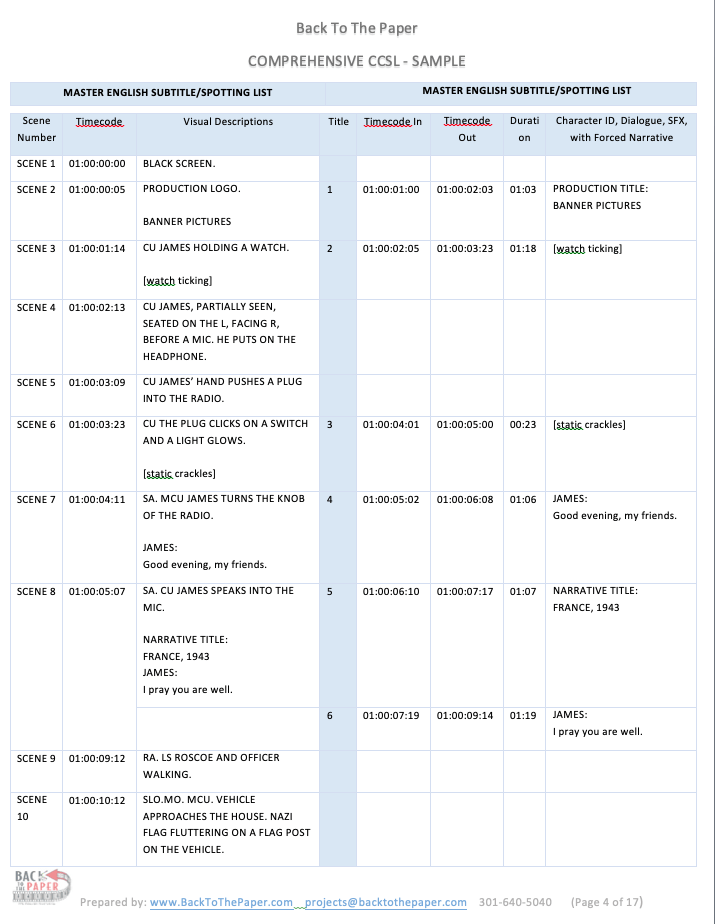
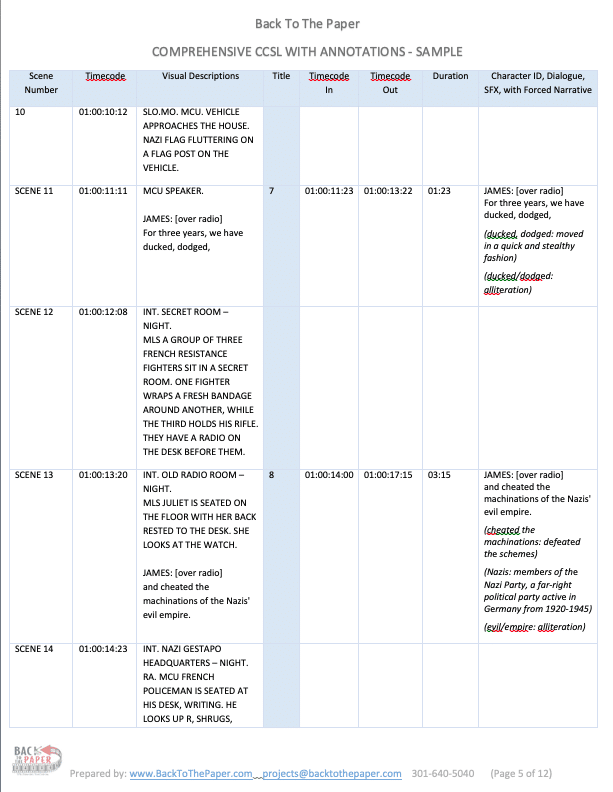
CCSL with Dialogue Annotations
$22.00 per minute
Includes:
- Scene number
- Scene time code
- Succinct scene descriptions
- Dialog number
- Dialogue Time Code In
- Dialogue Time Code Out
- Dialogue Duration
- Dialog with Speaker ID with Annotation
CCSL With Film Time Code
$20.00 per minute
Includes:
- Scene number
- Scene Video Time Code and Film Time Code
- Succinct scene descriptions
- Dialog number
- Dialogue Video Time Code In and Film Time Code In
- Dialogue Video Time Code Out and Film Time Code Out
- Dialogue Duration Video and Film
- Dialog with Speaker ID
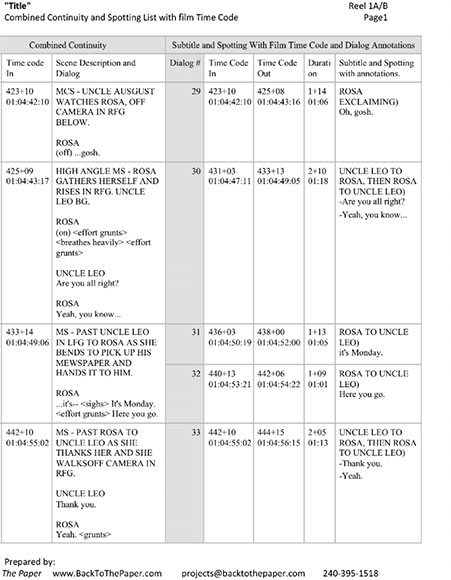
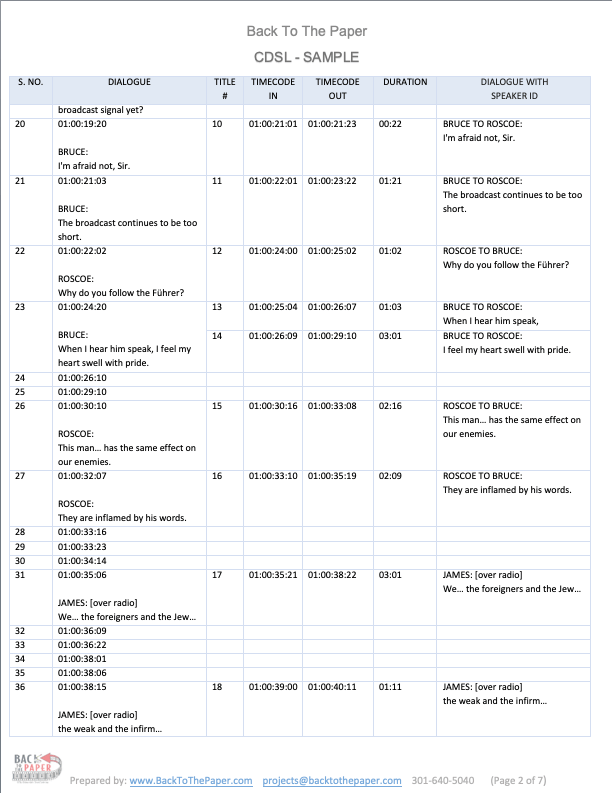
CDSL
Combined Dialogue and Spotting List
A CDSL stands for Combined Dialogue and Spotting List, but it can get very confusing. Many networks actually use this abbreviation when they actually mean a CCSL.
A CDSL does not have action continuity but is similar to a CCSL in all other respects. On the dialogue side, the entire dialogue is written without breaking it into individual subtitles. And on the right hand side — on the Spotting List side — the same dialogue is broken into individual subtitles.
Why is it necessary to write it both ways?
When a translator translates the dialogue into another language, they actually replace the subtitles into the target language. It is very important to continue to retain the source language so they can both be compared at any time. Just imagine if the source language is gone, the translator would have no way to check the accuracy of the translation.
What’s so special about our CCSLs?
Editing an existing CCSL.
We’ve created a cutting-edge program that enables our continuity script writers to match the visual scene to the dialog with precision and ease.
This has enabled us to make changes to an existing CCSL document easy so our customers don’t have to pay an arm and a leg if there’s an edit in the final movie after it has been delivered.
Or if there are different versions of the same video content.
Or if your movie is being delivered to different networks with different duration.
We’ve done it a thousand times!
This ability to tweak an existing CCSL to match to different time codes can save you thousands of dollars. We can also change the time code from 29.97 fps to 23.98 fps or 24fps. The flexibility that our system offers is unmatched. No one else can do this for you for so little.
Domestic and Foreign Market CCSL - we got them all covered.
If you have multiple versions of a movie or a television show that each requires a CCSL, we don’t have to go back to the drawing board to reinvent the wheel.
With our program we only need to make a few tweaks, and viola, a new CCSL is created — saving you big money!
CCSL Sample Videos
Download the CCSL sample of the two videos below and see how a CCSL is created. You can play the video while you scan the pdf of the CCSL.
Multiple Reformats to a different network or a different time code:
Difference between Comprehensive and Simple CCSL
The continuity action (scene description) in a Simple CCSL is written in layman’s language compared to a comprehensive CCSL.
This is actually a better way to write action continuity than the more complex language that includes camera angles, shot size and other technical detail. This is how a CCSL should be written so that it can make sense to a regular person.
Just understanding the visual action is all that is really needed and most of the time one does not need to know a camera angle or a shot size (MS medium shot, or ECU extreme close up) or camera placement (top angle or over the shoulder shot) or camera movement (dolly shot, or pan right).
A simple CCSL does the job very well and in fact better than a comprehensive CCSL.
Is it a CCSL or a CDSL or CCDSL (What's the difference?)
It can become most confusing for producers as the names of the post production scripts can be interchanged with each other. There is no industry standard as such. Mostly though the combined continuity list is known as a CCSL. We understand the confusion. The best way to figure out if you need is a CCSL (with shot description) or just a CDSL (without the shot description) is to look for words:
Scene description
Action continuity
Description of the action
Here are some of the text that are used by networks and film distributors:
Combined Continuity and Spotting List: One (1) copy in Microsoft Word format of a complete, industry standard, English-language Combined Continuity and Spotting List (CCSL) created from the final version of the Picture and Trailer as approved by Sales Agent. CCSL shall include cut-by-cut frame and footage counts of all shots including location and camera angle, meticulous scene description, soundtrack music starts and stops, and include the complete main and end credits. If the Picture was recorded in a language other than English, the Continuity shall contain a literal English translation. Spotting list must give spot numbers for each subtitle, the footage of the start and end of the subtitle, indication of which character is speaking and the text. Footages for the CCSL should be calculated on an A/B-reel basis (2,000-foot reels) and referenced to 35mm film running time at 24 frames per second.
*******
Feature DCSL: An electronic copy of a detailed, final dialogue and action continuity, in an acceptable format, of the completed Picture and an electronic copy of a detailed, final spotting list, in an acceptable format, of the Picture. If the original language of the Picture or any part thereof is not English, the English subtitles must be included.
*******
- Combined Continuity and Spotting List (CCSL)
(a) One (1) typewritten copy in Microsoft Word format in the English language of
a detailed, final spotting list and dialogue and action continuity of the Picture
and Trailer, containing all dialogue, narration, sound vocals, as well as a
cut-by-cut description of the action of the Picture as finally edited for release,
conforming exactly to the Picture as delivered hereunder, suitable for
transmittal to censorship authorities and for use in connection with dubbing
and subtitling the Picture; and
*******
Combined Continuity and Spotting List: One (1) electronic copy in Microsoft Word of a complete industry standard English language Combined Continuity and potting List (CCSL) created from the final version of the Picture specified in section I.B above. CCSL shall include cut-by-cut frame and footage counts of all shots including location and camera angle, meticulous scene description, soundtrack music starts and stops, and include the complete main and end credits. If the Picture was recorded in a language other than English, the Continuity shall contain a literal English translation.
Spotting list must give spot numbers for each subtitle, the footage of the start and end of the subtitle, indication of which character is speaking and the text.
Footages for the CCSL should be calculated on an A/B-reel basis (2,000 foot reels) and referenced to 35mm film running time at 24 frames per second.
*******
Change time codes from 29.97 fps to 23.98 fps or 24fps. Multiple time codes (what happens when your film is accepted by another network?)
Chances are that your movie or video will be played on more than one network. And each network will have a different set of requirements in terms of duration and rating.
Everytime you make even a little change – say a different logo at the beginning of the movie – the entire time code will change. Many times a movie has to be shortened by a few minutes and you as the producer will need to make several edits to do that. Which means all the timecodes in the CCSL will have to change. Several times. This can be extremely time consuming to do if you don’t have the right tools and experience.
Editing an existing CCSL.
At Back To The Paper we’ve created a cutting-edge program that enables our continuity script writers to match the visual scene to the dialogue with precision and ease. We can ripple the time code to match the new timecode. Or change from SD time code to HD timecode.
This has enabled us to make any changes to an existing CCSL document easy so you don’t have to worry about paying an arm and a leg if there’s an edit in the final movie after it has been delivered. Or if there are different versions of the same video content. Or if your movie is being delivered to different networks with different duration.
We’ve done it a thousand times!
This ability to tweak an existing CCSL to match to different time codes can save you thousands of dollars. Here’s what we can do with ease:
- Adjust the minor changes to time codes (like the change of a logo at the beginning of the feature) with ease and very nominal charge.
- Edit the CCSL as per the new EDL. The charges will vary relative to the changes in the feature.
The flexibility that our system offers is unmatched. No one else can do this for you for so little.
Timing for subtitling or for dubbing
Since we come from the closed captioning and subtitling world, we understand the nuances of time codes very well. For instance, time codes for translation for subtitles is different than for dubbing. The difference is not too much but it can make or break a good translation. In a subtitling time code, the end time code for a subtitle can hand a little extra time to make it easier to read. So whenever there is time available – when there is silence after a dialogue – we let the end time hang for a bit. But with dubbing, the lip movement has to be confined to the duration of the source dialogue. It is only with years of experience that we’ve come to understand the nuances so intimately.
Free trailers
The cost of creating a CCSL and closed captioning for a trailer is $200.00 which we offer for free with every CCSL and closed captioning combo.
Dialogue Annotations
Annotations are detailed explanations of anything that’s not 100% literal in a language that needs to be translated in order to create the most accurate, natural translation possible. It’s impossible to understand every expression and its true meaning to be able to do justice to faithfully convey the same meaning into another language.
There are many idioms, expressions, catchphrases, colloquialism, street talk, dialect, jargon, lingo, locution, similes, phraseology and many different ways to communicate in any language. Since almost every translator has a native tongue that he or she is translating into, the source language can be tricky at times.
Our skilled writers and editors analyze the script for any non-literal language, essentially reducing it down to the bare bones.
CCSL FAQ
What is a CCSL for?
Post-production scripts are usually a requirement for submitting a program for distribution/broadcast. They can be used as a map for technical work later, including subtitling, dubbing, and visual descriptions. In addition, they serve as a written documentation of every shot, every line, and every sound of a program, for legal and copyright purposes.
Do I need film footage time code?
Almost no one today needs the 35mm film footage count since nothing is shot on film reels anymore, and yet the networks don’t change the language in their production manuals. We still find this language in almost all production manuals that a network hands out to their producers. We encounter this every day.
Imagine a fresh graduate getting a job as a deliverable person at a television network and they encounter this very esoteric abbreviation – CCSL — in the production manual that they need to hand off to the producer. The CCSL deliverable language is a bunch of words which really do not make much sense. Unless one would go into detail as to what it actually means, and if that is what is really required and has been delivered in the past, one would not want to rock the boat. It’s better to let it stay. So it stays there, but is really not expected to be followed.
The best way to make sure wha the network or distributor is looking for is to reach out to them and ask them if they really need 35mm film footage. Even better, ask them for a sample of a CCSL that they want. In case they do need 35mm film footage we can definitely do that, but it’s a very tedious process and can take several extra days and more money to do.
We can say this with complete confidence that they are not looking for the 35mm film footage. And just in case you deliver them a regular CCSL without the film footage and they revert back saying that they do need film footage, we can then add that to the existing CCSL. Given that, I think it’s probably prudent not to have the film footage added at this stage.
The first number is the number of the feet and the number after the + are the frames. (In 35mm, there are 16 frames in one foot of film, and of course, 24 frames in a second). I am also attaching our normal CCSL sample for you and your network to compare.
Time Code:
The default choice for expressing the point in a video where your caption appears or your scene changes, expressed in Hour:Minute:Second:Frame. For example, a minute and a half would be expressed as 00:01:30:00, as one minute and 30 seconds have passed.
Footage/Frames: Another measurement of time in a video, this method is the calculation the point where a caption appears or scene changes based on the physical length of film that has been used, expressed as Feet.Frames. So, for example, one second of film would be expressed as 1.8, because there are 16 frames in one foot, and 24 frames in a second of film. You can choose to use footage/frames in addition to or instead of time code in your scripting project.
What are Forced Narrative:
Here’s a good explanation on Netflix’s website on Forced Narrative:
https://partnerhelp.netflixstudios.com/hc/en-us/articles/217558918
A Forced Narrative subtitle is a text overlay that clarifies communications or alternate languages meant to be understood by the viewer. They can also be used to clarify dialogue, texted graphics or location/person IDs that are not otherwise covered in the dubbed/localized audio. To enable the same viewing experience across multiple countries and devices, FN subtitles are localized and delivered as separate timed text files. The picture in your primary video (A/V MUX) that would otherwise have subtitles is required to be delivered as a non-subtitled file, or textless. Subtitles, both full and FN, are not burned-in over picture.
If you are creating closed captioning or SDH for Netflix, Forced Narrative subtitles are only displayed if full Subtitles and CC are set to “off” in the user’s playback settings. When the user activates a full Subtitle or CC file, the FN subtitle does not display and for this reason, we require that all Forced Narrative events are also included in each full Subtitle and SDH/CC file.
Request a Quote
Call Us : 301-500-2123
- A low resolution downloadable proxy video with window burn (BITC).
- Anything around 2GB is fine (but the smaller the better as long as the audio is clear and visuals are sharp).
- If you send us a Vimeo or a Dropbox link, please make them downloadable.
- If you send us a Google drive link, please send it to ttvideodrive@gmail.com
- Any shooting script or text of the movie that you might have. It helps us with names etc.
- End credits in MS Word or .txt
- Our standard non-disclosure agreement/contract.
- Invoice that will need to be paid before we deliver the file to you.
- CCSL in MS Word and closed captioning, if ordered, in scc, srt, .cap or any format that you need.
